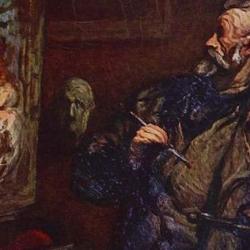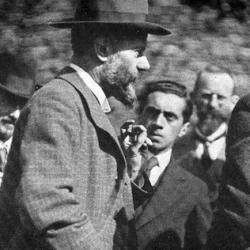Walter Benjamin had no totalizing philosophical system. He was an essayist, admits Ranier Rochlitz (The Disenchantment of Art). Rochlitz doesn’t use the term to demean, however. Benjamin “is not an essayist in the manner of Montaigne; the scientific imperative is not lacking in his essays. He conducts concrete research from a philosophical perspective.” In his essays, Benjamin “created or rethought numerous concepts that are part of philosophical debates today: notably, truth content and subject matter, symbol and allegory, aura and mechanical reproduction, cult value and exhibition value, dialectical image and remembrance” (9).
Though there is no system, “we can nevertheless speak of a fundamental schema in his approach and philosophical conception.” There is a framework that Rochlitz describes as a description of progress in history: “the succession of catastrophes that moves from a fullness of meaning, impure because of its mythical character, to a poverty of meaning incarnated by abstract ‘meaning’ and by the ‘reification’ of the mechanically reproduced commodity, Benjamin seeks to mark the pauses where the liberating ‘genius’ of humanity has manifested itself while pointing toward a decisive liberation” (9).
Art gas “a privileged place” in this account of the genius of humanity breaking out of a process of abstraction, but its role is defined by the fact that it stands out as an enchantment in contrast to the disenchantment of reason. As Rochlitz puts it, “art occupies a privileged place, but only to the extent that the enchantment of its appearance is dominated by the disenchantment proper to knowledge.” Thus, “Greek tragedy, baroque allegory, Charles Baudelaire’s modern poetry, and revolutionary film are among these privileged moments where a loss of meaning is heroically converted into a symbolic form free from all pretense” (9). Benjamin formulates this framework in different ways: “from the first conception of a world of Ideas bringing together authentic forms to the transformation of the critical act into political action, and from the privileging of the actualization or destruction of tradition to the remembrance of a past threatened with definitive occultation.” Throughout, “the idea of rescuing a liberating act of signification, forgotten or disregarded by the official tradition, remains constant” (9-10).
Art itself participates in the disenchantment of the world. What Benjamin describes as the destruction of the “aura” makes its first appearance in his “A Small History of Photography” and more fully in “The Work of Art in the Age of Mechanical Reproduction.” In the latter, “Benjamin attacks the religious foundations of as they dominate the aesthetic experience in the traditional sense; according to him, this experience is contemplative and fetishistic. This theory draws inspiration from the Weberian theses on desacralizarion. But what will replace the ritual underlying_any work of art is now, according to Benjamin: not an autonomous experience but rather politics: not the ideal receiver, God, but the idealized receiver, the public of the struggling class” (149). Benjamin eventually admits that art does not evolve as he predicted. In an essay on “The Work of Art,” he argues that film brings a crisis to art in general. Yet, “For better or for worse, however, art has survived the crisis precipitated by film, just as it survived Dadaism, which, if we are to believe Benjamin, was only the prelude to cinematic shock effects. Above all, even if we except commercial film, film itself has hardly evolved in the direction of politicization announced by Benjamin; it has not radically escaped the field of art” (149).
He defines the aura in his essay on art in an age of reproduction. It is “a strange weave of space and time: the unique appearance of semblance or distance, no matter how close the object may be.” Rochlitz glosses this with: “Two negative qualities seem to define the aura: the uniqueness of a moment of temporal apparition and its unapproachability, its distancing despite a possible spatial proximity” (152).
Benjamin finds the root of his account of the destruction of the aura in Hegel, whom Benjamin quoted in Illuminations: “are beyond the stage of reverence for works of art as divine and objects deserving our worship. The impression they produce is one of a more reflective kind, and the emotions they arouse require a higher test” (quoted Rochlitz, 150). At heart, Benjamin’s theory isn’t philosophical but sociological. He draws on Weber and Simmel in concluding that the destruction of the aura is part of a “general disenchantment of the world, so much so that art, now without effect on public life, survives only in the private sphere.” Like Nietzsche, Benjamin reacts to this decline, but not, in line with Nietzsche, with a plea for the aestheticization of life. Rather, “Inasmuch as the ‘beautiful appearance’ of art is now mere lies and artifice, it is no longer appropriate to celebrate pure and simple appearance, the vital lie that brings us intense experiences: Rather, we must sacrifice art in the traditional sense to preserve the public status and the pragmatic role of its productions. Unlike Max Weber, Benjamin is not part of the tradition of a ‘Protestant’ and rationalist critique of the image, nor does he confine himself to observing in a general way the desacralization of art; he under takes to precisely show the modifications that certain arts have undergone, according to their technical composition, their relation to reality, and the social context of their reception” (150).
Photography dispels the aura, but not instantly. In his small history of photography, he argues that the very techniques of early photography preserve the aura of art. Because photographs required “a long and concentrated exposure,” they capture a continuum from light through shadow to absolute darkness. Early group photos preserve a feeling of conviviality. Photographs preserved an aura because of a “rigorous congruence between ‘subject and technique.’” The technology existed within the world of the burgeoning bourgeois class, as it existed on the photographic plate. As the bourgeoisie triumphed, this aura disappeared and mere artifice took its place. In Benjamin’s words: “After 1880, though, photographers made it their business to simulate with all the arts of retouching, especially the so-called rubber print, the aura which had been banished from the picture with the rout of darkness through faster lenses, exactly as it was banished from reality by the deepening degeneration of the imperialist bourgeoisie” (151). Modernity brings needs and values to the fore that are incompatible with the aura, that push against the distancing effects of the aura: “To bring things closer to us, or rather to the masses, is just as passionate an inclination in our day as the overcoming of whatever is unique in every situation by means of its reproduction. Every day the need to possess the object in close-up in the form of a picture, or rather a copy, becomes more imperative ” (152). Instead of the distancing associated with the aura, modernity promotes a proximity that edges close to possession, a reflex of bourgeois capitalist appropriation.
Benjamin doesn’t lament the decline of the aura; rather the reverse. Referring to the surrealist photography of Eugene Atget, he writes, “He was the first to disinfect the stifling atmosphere generated by conventional portrait photography in the age of decline. He cleanses this atmosphere, indeed he dispels it altogether: he initiates the emancipation of object from aura which is the most signal achievement of the latest school of photography” (quoted, 152). Yet his language sometimes suggests a feeling of loss, a loss of the uniqueness of things: “The stripping bare of the object, the destruction of the aura, is the mark of a perception whose sense of the sameness of things has grown to the point where even the singular, the unique, is divested of its uniqueness – by means of its reproduction” (quoted, 152).
In summary, Rochlitz claims there are three reasons for the destruction of the aura: “aesthetic authenticity, which is opposed to artifice; ethics (or politics), the questioning of privilege and of the exclusive character of the aura; and, finally, anthropology, a metamorphosis of perception, moving in the direction of a primacy of the cognitive attitude, which Benjamin notes here without making a value judgment.” This last, he notes, is linked with the Hegelian/Weberian theme of ” the progression of the rational mind in Western culture, in the sense of a progress of cognitive rationality” (152-3).















